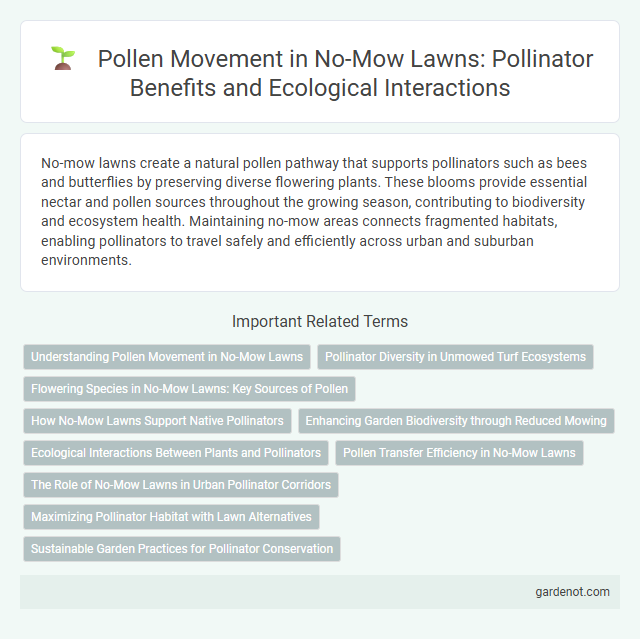No-mow lawns create a natural pollen pathway that supports pollinators such as bees and butterflies by preserving diverse flowering plants. These blooms provide essential nectar and pollen sources throughout the growing season, contributing to biodiversity and ecosystem health. Maintaining no-mow areas connects fragmented habitats, enabling pollinators to travel safely and efficiently across urban and suburban environments.
Understanding Pollen Movement in No-Mow Lawns
Pollen movement in no-mow lawns occurs primarily through wind and insect activity, facilitating cross-pollination among diverse native plant species. The undisturbed vegetation structure supports a rich ecosystem of pollinators such as bees and butterflies, enhancing genetic diversity and plant resilience. Understanding these natural pollen pathways is crucial for optimizing pollination success and maintaining the ecological balance within no-mow lawn environments.
Pollinator Diversity in Unmowed Turf Ecosystems
Unmowed turf ecosystems create critical pollen pathways that enhance pollinator diversity by providing continuous floral resources and habitat connectivity. These lawns support native bees, butterflies, and other pollinators by preserving diverse wildflower species often lost in regularly mowed areas. Maintaining no-mow zones increases pollinator abundance and resilience, promoting healthier urban biodiversity and ecosystem services.
Flowering Species in No-Mow Lawns: Key Sources of Pollen
Flowering species in no-mow lawns, such as clover, dandelions, and wild violets, serve as vital sources of pollen for local pollinators including bees and butterflies. These diverse blooms contribute to the pollen pathway by supporting pollinator health and promoting biodiversity within urban and suburban landscapes. Maintaining no-mow areas encourages a continuous pollen supply that enhances ecosystem resilience and plant reproduction.
How No-Mow Lawns Support Native Pollinators
No-mow lawns create essential pollen pathways by allowing native wildflowers and grasses to bloom uninterrupted, providing continuous food sources for native pollinators like bees, butterflies, and hoverflies. These habitats boost biodiversity by supporting the life cycles of pollinators critical for ecosystem health and agriculture. Maintaining no-mow areas increases the availability of nectar and pollen, directly contributing to the survival and reproduction of native pollinator populations.
Enhancing Garden Biodiversity through Reduced Mowing
Pollen pathways created by reduced mowing support vital pollinators such as bees and butterflies, enhancing garden biodiversity significantly. Allowing native wildflowers and grasses to flourish increases nectar availability and habitat complexity, promoting ecological balance. Maintaining no-mow zones contributes to healthier pollinator populations and improved plant diversity in urban and suburban gardens.
Ecological Interactions Between Plants and Pollinators
No-mow lawns create diverse pollen pathways by allowing native and flowering plants to thrive, supporting essential ecological interactions between plants and pollinators such as bees, butterflies, and hoverflies. This habitat diversity enhances pollination networks, increases plant reproduction rates, and promotes biodiversity within urban and suburban environments. Maintaining these no-mow areas contributes to resilient ecosystems by sustaining food sources and nesting sites for pollinator populations.
Pollen Transfer Efficiency in No-Mow Lawns
Pollen transfer efficiency in no-mow lawns significantly enhances plant reproduction by providing a stable habitat for pollinators like bees and butterflies, which improves pollen dispersal among wildflowers and grasses. The structural complexity and diverse flowering species in no-mow lawns create optimal conditions for effective pollen pathways, increasing cross-pollination rates and genetic diversity. Reduced mowing frequency minimizes disturbance, allowing pollen to remain viable longer and facilitating sustained pollination activity throughout the growing season.
The Role of No-Mow Lawns in Urban Pollinator Corridors
No-mow lawns serve as critical pollen pathways, enhancing the connectivity of urban pollinator corridors by providing continuous floral resources for bees, butterflies, and other pollinating insects. These low-maintenance landscapes increase native plant diversity and bloom time, supporting pollinator foraging throughout the growing season. Integrating no-mow lawns into urban planning mitigates habitat fragmentation and promotes pollinator population resilience in heavily developed environments.
Maximizing Pollinator Habitat with Lawn Alternatives
Planting native wildflower strips and clover patches within no-mow lawn areas significantly enhances pollen pathways, supporting diverse pollinator species. These lawn alternatives provide continuous floral resources throughout the growing season, maximizing habitat connectivity and boosting pollinator foraging efficiency. Optimizing plant diversity and bloom timing in no-mow zones fosters robust pollinator networks essential for ecosystem health and biodiversity.
Sustainable Garden Practices for Pollinator Conservation
No-mow lawns create essential pollen pathways that support pollinator biodiversity by providing continuous floral resources throughout the growing season. These sustainable garden practices reduce pesticide use and soil disturbance, promoting healthy habitats for bees, butterflies, and other pollinators. Integrating native flowering plants within no-mow zones enhances ecosystem resilience and supports long-term pollinator conservation efforts.
Pollen pathway Infographic

 gardenot.com
gardenot.com